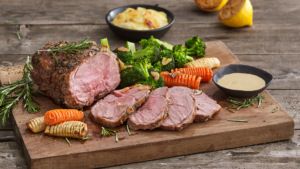Things to do
Easter 2022: How to make …
This article is more than 3 years old.

(photo: Rema1000)
Easter Lamb
Joint of lamb
Salt & pepper
Onion
Carrot
Stalk of celery
Bay leaf
Various herbs
Garlic
350ml of beer
1 Start planning well in advance of Easter, scanning the freezer sections of local supermarkets. Lamb joints, both legs and shoulders normally from New Zealand, tend to be offered on discounts and can be snapped up for half the price of a fresh joint nearer the time. Rema 1000 tend to the best bet, although my local store sold out within hours of opening last Sunday.
2 Defrost a good 24 hours in advance. Leave at room temperature and place in roasting dish. Cut garlic into slivers and push into inserts all over the meat. Sprigs of rosemary is the most popular herb of choice (remove before carving though), but other herbs will do just as well: thyme, dill, parsley, coriander. Salt and pepper generously.
3 Preheat oven to 175 degrees Celsius (without a fan) and cook lamb at same temperature throughout. Alternatively, you might choose to roast at 220 for the first 30 minutes and then turn it down to 160-170. Either way, give yourself three hours cooking time.
4 After 60 minutes, thinly slice onion, carrot and celery with a bay leaf and the beer and pour over the roast. With two hours until completion, this might be a good opportunity to add a few par-boiled potatoes and parsnips (save the water they were boiled in for later), if you like the final result to be crusty but on the soggy side. They’ll still be delicious but don’t overly crowd the oven dish.
5 Baste frequently and turn over vegetables after 60-80 minutes.
6 Upon completion, save juices and what remains of the onion, carrot and celery, place roasting dish on the stove, and use flour, whisk and juices to take the residue off the pan. Modify the thickness of the gravy with saved water.
7 Serve lamb with potatoes, parsnips, carrots, peas, leeks and broccoli in cheese sauce.
8 Postscript: we wanted this to be an authentic Danish dish, but let’s face it: they’re generally clueless when it comes to roasts. One of the recipes even wanted to garnish with cooked pepper, squash rings, orange slices and mint jelly. Ew!










































